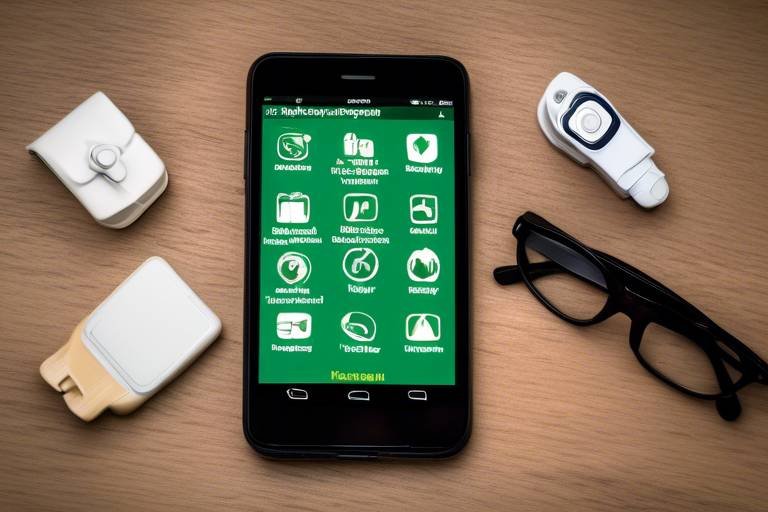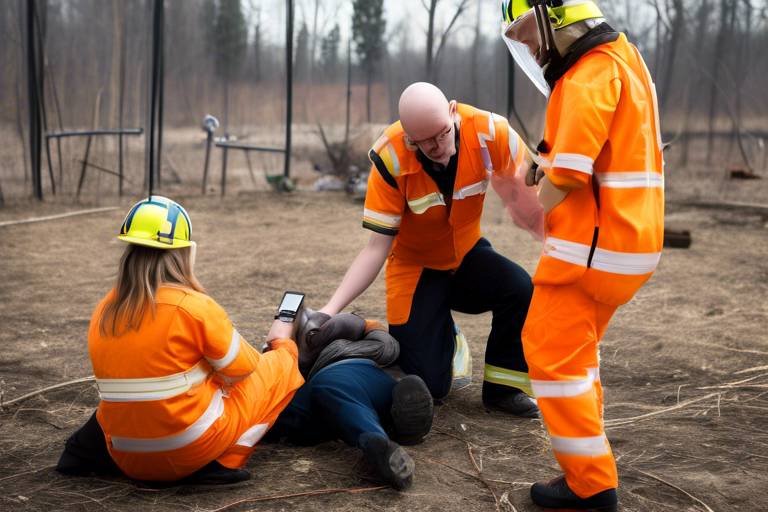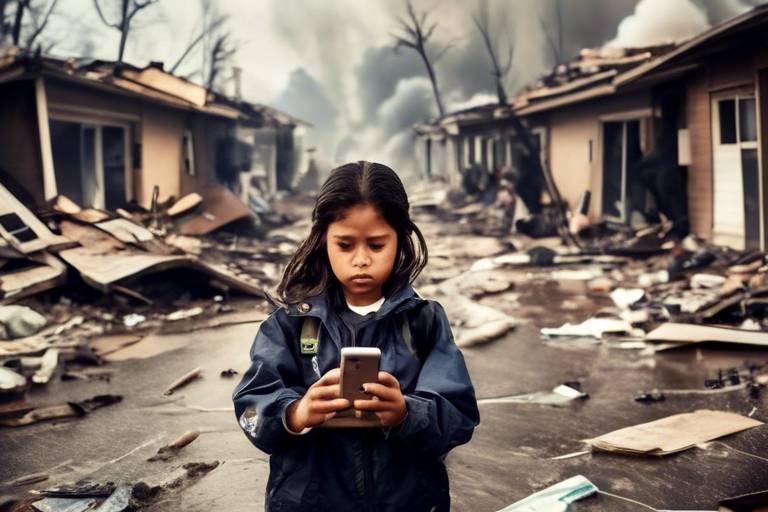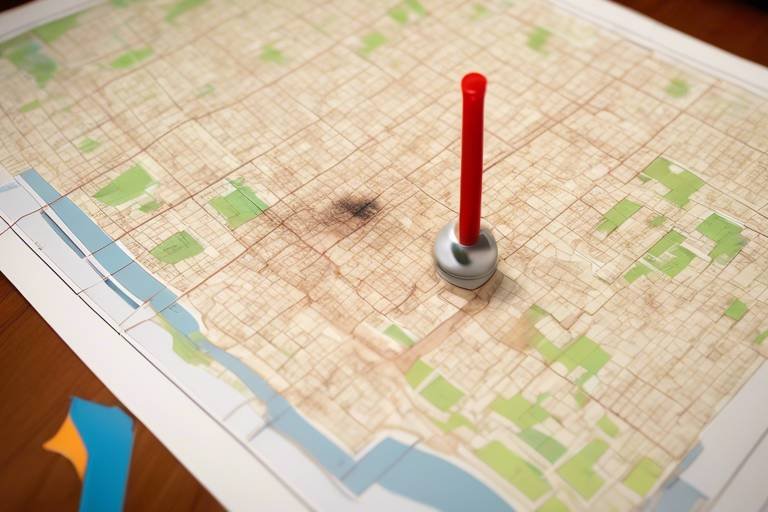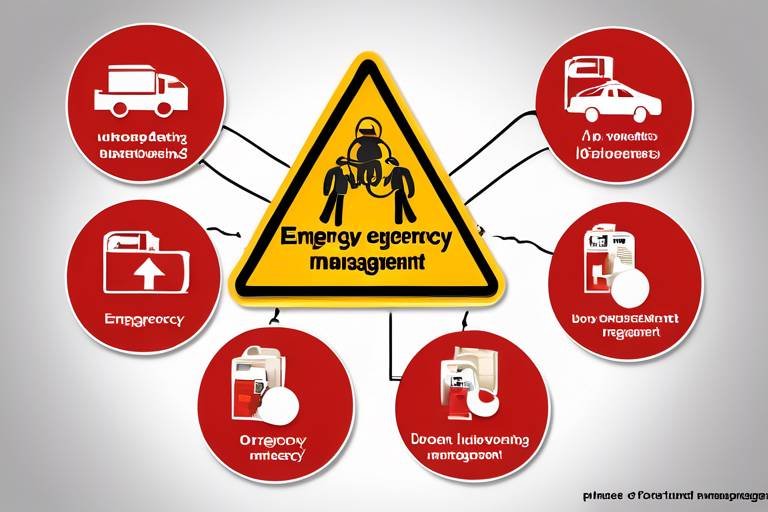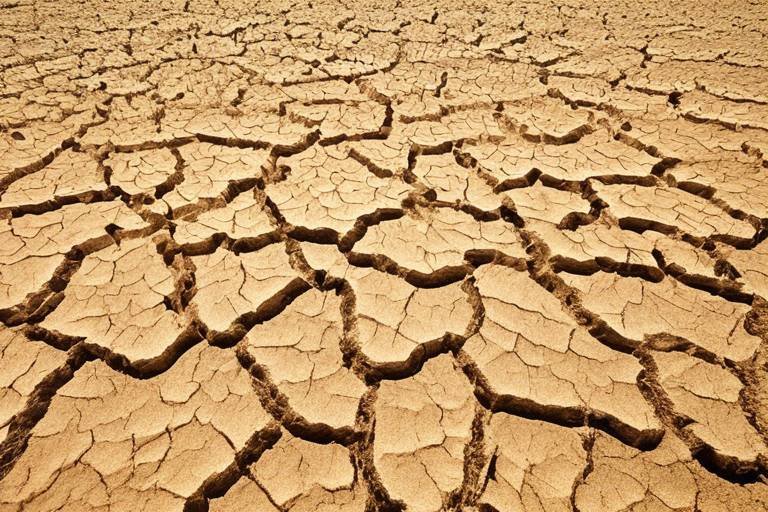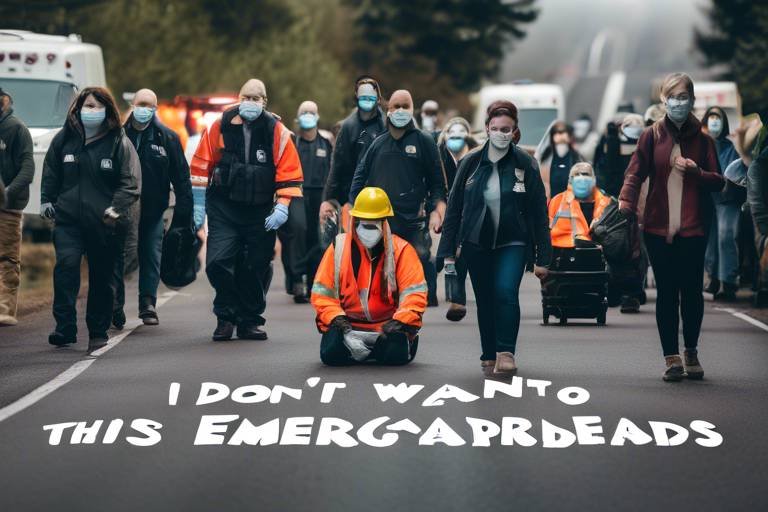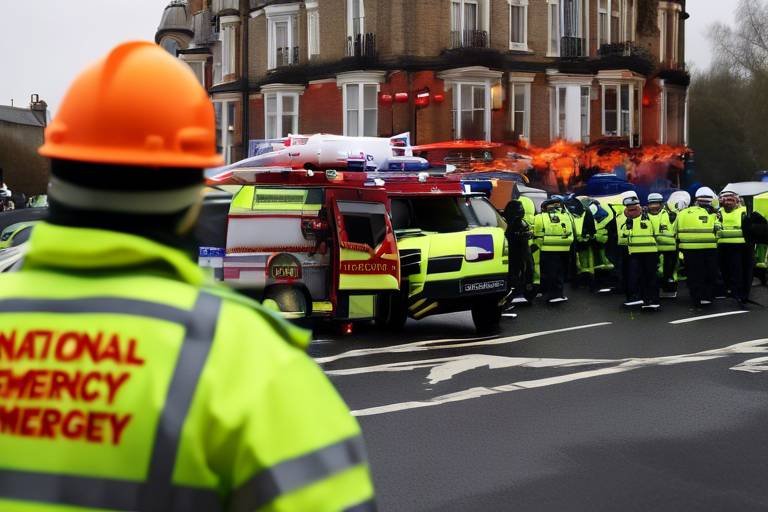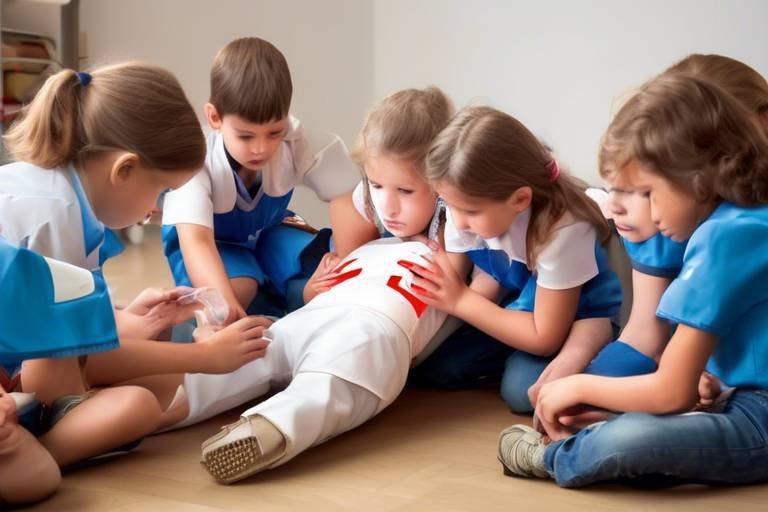How to Join a Disaster Response Team?
Joining a disaster response team is a noble pursuit that not only allows you to contribute to your community but also equips you with invaluable skills and experiences. If you're passionate about helping others in times of crisis, you're in the right place! In this article, we will walk you through the essential steps and considerations for becoming a member of a disaster response team. From understanding the vital roles these teams play to the specific qualifications and training you need, every detail matters. So, are you ready to make a difference?
Disaster response teams are the unsung heroes during emergencies, acting swiftly to manage crises and save lives. These teams come in various forms, including local volunteer organizations, government agencies, and specialized units like search and rescue teams. Their primary functions encompass a range of activities:
- Assessing Situations: Quickly evaluating the needs and conditions in disaster-stricken areas.
- Providing Medical Aid: Offering first aid and emergency medical services to those in need.
- Coordinating Resources: Collaborating with various agencies to ensure effective resource allocation.
- Restoring Order: Helping to maintain safety and security in chaotic environments.
The importance of their work cannot be overstated; they play a crucial role in minimizing the impact of disasters, providing relief, and restoring hope to affected communities. If you feel a calling towards this line of work, keep reading to find out how you can get involved.
Before you dive in, it's essential to understand that joining a disaster response team requires specific qualifications. These qualifications are not just a formality; they ensure that you are adequately prepared to handle the challenges that may arise during emergencies. Here’s what you generally need:
- Basic Skills: Strong communication, teamwork, and problem-solving abilities.
- Certifications: Relevant certifications in first aid, CPR, or specialized disaster response training.
- Experience: Volunteer experience in related fields can be a significant advantage.
These qualifications help create a strong foundation for effective teamwork and efficient response efforts. Remember, being part of a disaster response team is not just about having skills; it's about working together towards a common goal.
Training is the backbone of disaster response. It prepares you for the unexpected and ensures that you can act decisively when lives are on the line. Here are some essential skills that you should focus on:
First aid and medical training are indispensable for anyone looking to join a disaster response team. In emergencies, every second counts, and having the ability to provide immediate care can mean the difference between life and death. Courses in first aid and CPR are widely available through organizations like the Red Cross, and they are a great place to start your journey.
Understanding search and rescue techniques is another critical aspect of disaster response. These methods involve locating and assisting individuals trapped or stranded in disaster-affected areas. Training often includes practical exercises that simulate real-life scenarios, giving you hands-on experience that is crucial when the moment arises.
Various certification programs can prepare you for roles in disaster response. These programs not only enhance your skills but also increase your credibility as a responder. Popular programs include:
| Certification Program | Offered By | Focus Area |
|---|---|---|
| Community Emergency Response Team (CERT) | FEMA | Basic disaster response skills |
| Advanced Medical Life Support (AMLS) | National Association of Emergency Medical Technicians | Advanced medical care |
| Search and Rescue Technician | Various local agencies | Search and rescue operations |
Choosing the right program can set you on the path to becoming an effective member of a disaster response team, so take the time to research your options!
Once you've equipped yourself with the necessary skills and qualifications, the next step is to find a local disaster response team to join. This can be a rewarding experience that not only allows you to apply your training but also fosters community involvement. Start by checking local government websites or community centers, which often have information on volunteer opportunities. Additionally, social media platforms can be a great resource for discovering local teams and initiatives.
Many organizations offer volunteering opportunities that allow you to get involved in disaster response. These can range from short-term events to long-term commitments. The application process usually involves an interview and background check, so be prepared to demonstrate your commitment and passion for helping others.
Networking with professionals in the field is another excellent way to enhance your chances of joining a disaster response team. Attend workshops, seminars, and community events where you can meet experienced responders. Building relationships with these professionals can provide you with valuable insights and mentorship, making your transition into disaster response smoother.
Preparation is key for effective disaster response. It’s not just about having the right skills; it’s also about being mentally and physically ready for deployment. Here are some essential steps to consider:
Having the right gear is critical for disaster responders. Your emergency kit should include items like:
- First aid supplies
- Flashlights and batteries
- Non-perishable food and water
- Protective clothing and gear
Being well-prepared can make a significant difference in your effectiveness during a deployment.
Lastly, staying informed about disaster response practices is vital. The field is always evolving, with new techniques and technologies emerging regularly. Subscribe to relevant newsletters, participate in training sessions, and engage in continuous learning to keep your skills sharp and your knowledge current.
Q: Do I need prior experience to join a disaster response team?
A: While prior experience can be beneficial, many teams welcome individuals who are eager to learn and contribute.
Q: How much time do I need to commit?
A: Commitment levels vary by team, but many organizations offer flexible volunteering options.
Q: What if I don't have medical training?
A: There are many roles within disaster response teams that do not require medical training, such as logistics and support.

Understanding Disaster Response Teams
Disaster response teams are the unsung heroes that step into the chaos when emergencies strike. These dedicated groups are often the first on the scene, working tirelessly to manage crises and provide essential support to those affected. Their work is not just about responding; it's about saving lives, offering relief, and restoring hope in the aftermath of disasters. Imagine a community hit by a sudden earthquake or a devastating flood—who do you think rushes in to help? That’s right, it’s the disaster response teams, comprised of brave volunteers and professionals who are trained to handle the unexpected.
There are various types of disaster response teams, each specializing in different aspects of emergency management. For instance, some teams focus on search and rescue operations, while others may be trained in providing medical assistance. The roles within these teams can be as diverse as the disasters they respond to. Here’s a quick overview of the main types of disaster response teams:
| Type of Team | Primary Function |
|---|---|
| Search and Rescue Teams | Locate and assist individuals trapped or stranded during disasters. |
| Medical Response Teams | Provide immediate medical care to injured individuals. |
| Logistics Support Teams | Manage supplies, equipment, and resources needed during emergencies. |
| Community Outreach Teams | Engage with affected communities to assess needs and provide support. |
The importance of disaster response teams cannot be overstated. They are often the lifeline for those caught in the turmoil of natural disasters, industrial accidents, or even terrorist attacks. Their ability to mobilize quickly and efficiently can mean the difference between life and death. Moreover, these teams not only provide immediate assistance but also play a crucial role in the recovery process. They help communities rebuild and regain their footing after a disaster, fostering resilience and preparedness for future incidents.
Another vital aspect of disaster response teams is their emphasis on teamwork. In high-pressure situations, effective collaboration can significantly enhance the efficiency of response efforts. Each member brings unique skills and perspectives, creating a well-rounded approach to tackling emergencies. Whether it’s coordinating with local authorities, managing logistics, or providing psychological support to victims, the synergy within a disaster response team is what makes them effective.
In summary, understanding the roles and functions of disaster response teams is essential for anyone considering joining one. These teams are not just about responding to disasters; they are about building a community of support and resilience. If you’re ready to take the plunge and become part of this incredible network of helpers, you’re already on your way to making a significant impact in the lives of others.

Qualifications for Joining
Joining a disaster response team is not just about the desire to help; it requires a specific set of qualifications that ensure you can effectively contribute to the team's goals. These qualifications often include a combination of skills, certifications, and personal attributes that together form a well-rounded responder. So, what exactly do you need to bring to the table? Let's break it down.
First and foremost, having the right skills is essential. Disaster response teams operate in high-stress environments where quick thinking and decisive action can save lives. Therefore, prospective members should possess strong communication skills, as they will often need to coordinate with other team members and possibly communicate with victims. Additionally, problem-solving abilities are crucial, as responders must quickly assess situations and determine the best course of action.
In terms of certifications, many organizations require members to have completed specific training programs. For instance, certifications in First Aid and CPR are typically mandatory. These certifications not only equip you with the necessary skills to provide immediate care in emergencies but also demonstrate your commitment to the role. Furthermore, specialized training in areas such as hazardous materials handling or emergency management can significantly enhance your qualifications.
Experience also plays a vital role in your readiness to join a disaster response team. Many teams prefer candidates who have prior volunteer experience in emergency situations or related fields. This could include volunteering with local fire departments, participating in community emergency response teams (CERT), or even involvement in organizations like the Red Cross. Such experiences provide practical knowledge and help you understand the dynamics of working in a team during a crisis.
Moreover, personal attributes cannot be overlooked. Being physically fit is important, as disaster response can involve strenuous activities such as lifting, running, or navigating through difficult terrains. Mental resilience is equally critical. Responders often encounter traumatic situations, and having a strong mental fortitude can make a significant difference in how effectively you can perform your duties.
To summarize, the qualifications for joining a disaster response team can be grouped into three main categories:
- Skills: Communication, problem-solving, and teamwork.
- Certifications: First Aid, CPR, and specialized training.
- Experience: Volunteer work and practical knowledge.
By equipping yourself with these qualifications, you position yourself as a valuable asset to any disaster response team. Remember, it's not just about what you know; it's about how you can apply that knowledge in real-life situations to make a difference when it matters most.

Essential Skills and Training
When it comes to joining a disaster response team, having the right skills and training is absolutely essential. Think of it like preparing for a marathon; you wouldn't just show up at the start line without months of training, right? Similarly, aspiring disaster responders need to equip themselves with a toolkit of abilities that will enable them to act effectively in high-pressure situations. This isn't just about knowing what to do; it's about being able to do it while chaos unfolds around you.
First and foremost, first aid training is non-negotiable. In the aftermath of a disaster, injuries can range from minor cuts to severe trauma, and being able to provide immediate care can save lives. Knowing how to assess a situation, apply bandages, or perform CPR can make a world of difference. Many organizations offer courses that certify individuals in basic and advanced first aid, and these certifications are often prerequisites for joining a team.
Another crucial skill is search and rescue techniques. This involves understanding how to locate and assist individuals who may be trapped or in distress. Whether it's navigating through debris or using specialized equipment, responders need to be well-versed in various methods. For example, knowing how to use a map and compass can be as vital as being able to operate a GPS device, especially in areas where technology may fail.
Additionally, crisis management skills are essential. Responding to a disaster isn't just about physical tasks; it's also about making quick decisions under pressure. Training programs often include simulations that mimic real-life scenarios, helping responders practice their decision-making skills in a controlled environment. This preparation is invaluable, as it helps build confidence and readiness for actual deployment.
To further illustrate the importance of these skills, consider the following table that summarizes key training areas and their benefits:
| Training Area | Benefits |
|---|---|
| First Aid | Immediate care for injuries; life-saving skills |
| Search and Rescue | Ability to locate and assist individuals; effective use of equipment |
| Crisis Management | Improved decision-making; enhanced teamwork under pressure |
Finally, it’s important to remember that training doesn’t stop once you join a team. Continuous education through workshops, seminars, and hands-on drills ensures that responders stay updated on the latest techniques and technologies in disaster management. The world of disaster response is always evolving, and being adaptable is key to providing the best possible assistance when it’s needed most.
So, are you ready to take the plunge? Equip yourself with these essential skills, and you’ll be well on your way to making a significant impact in disaster response efforts.
- What qualifications do I need to join a disaster response team?
While specific requirements vary by organization, most teams look for individuals with first aid training, crisis management skills, and a willingness to learn. - How long does training take?
Training duration can vary widely depending on the program, but many basic certifications can be completed in a few days to a few weeks. - Can I volunteer without prior experience?
Absolutely! Many organizations welcome volunteers and provide the necessary training to get you started.

First Aid and Medical Training
When it comes to joining a disaster response team, are not just optional—they are absolutely essential. Imagine being in a chaotic environment where every second counts, and you are the one who can make a difference. Having the ability to provide immediate care can be the line between life and death for someone in distress. This training equips you with the skills needed to assess injuries, perform basic life support, and manage medical emergencies effectively.
First aid training covers a wide range of topics, from treating cuts and scrapes to performing CPR. It also includes understanding how to handle more severe injuries such as fractures or head trauma. The knowledge gained through these programs not only prepares you for emergencies but also instills a sense of confidence in your ability to act decisively when it matters most.
Furthermore, many organizations offer specialized courses that go beyond basic first aid. These may include advanced medical training, such as trauma care or emergency response techniques, which are particularly useful in disaster situations. For instance, knowing how to control bleeding or stabilize a patient before they are transported to a medical facility can significantly improve outcomes.
Here are some key components of first aid and medical training that every disaster responder should consider:
- Basic Life Support (BLS): This includes CPR and the use of automated external defibrillators (AEDs), which can be lifesaving in cardiac emergencies.
- Wound Care: Learning how to clean, dress, and manage various types of wounds is crucial for preventing infections.
- Splinting Techniques: Knowing how to immobilize fractures can prevent further injury during transport.
- Recognizing Shock: Understanding the signs of shock and how to treat it can be vital in saving lives.
Taking the time to complete these training programs not only enhances your skill set but also makes you a valuable asset to any disaster response team. The confidence and knowledge you gain will empower you to act effectively under pressure, ensuring that you can provide the best possible care when it’s needed most. So, if you're serious about joining a disaster response team, start with first aid training—it's the foundation upon which all other skills are built.

Search and Rescue Techniques
When disaster strikes, every second counts, and understanding can mean the difference between life and death. These techniques are designed to locate and assist individuals who may be trapped or in distress after a disaster. Imagine a scene where a building has collapsed, and time is of the essence; knowing how to effectively search for survivors can save lives. Search and rescue operations can be complex and require a combination of skills, teamwork, and strategic planning.
One of the fundamental aspects of search and rescue is the initial assessment. This involves evaluating the scene to determine the safest and most effective approach to begin the rescue. Teams often use a methodical approach, starting from the most accessible areas and working their way to more challenging spots. They assess potential hazards that could pose risks to both the rescuers and the victims, such as unstable structures or hazardous materials.
After the initial assessment, teams typically employ various techniques and tools to locate victims. Some of these include:
- Visual Search: This involves scanning the area for signs of life, such as movement or sounds. Rescuers often call out to potential victims to elicit a response.
- Listening Techniques: In a quiet environment, rescuers may use listening devices to detect sounds that indicate a person is trapped.
- Canine Units: Trained dogs can be invaluable in search and rescue operations. They have an incredible sense of smell and can locate individuals buried under rubble.
- Technological Aids: Drones equipped with cameras can provide aerial views of disaster sites, helping teams identify areas where people may be trapped.
Once victims are located, the next step is often the extraction. This requires careful planning to ensure the safety of both the rescuer and the victim. Techniques such as using ropes, pulleys, and other rescue equipment are common. In some cases, rescuers may need to perform medical assessments on-site before moving the victim to a safer location.
Moreover, effective communication among team members is crucial. Rescuers must coordinate their efforts to ensure that everyone is aware of their roles and the status of the operation. This is where training and teamwork play a vital role. Regular drills and simulations can prepare teams for real-life scenarios, helping them to respond swiftly and effectively when the time comes.
In summary, search and rescue techniques are not just about physical skills; they encompass a wide range of strategies that require mental agility, teamwork, and a deep understanding of the environment. By mastering these techniques, disaster response teams can enhance their effectiveness and increase the chances of saving lives in critical situations.
Q1: What is the primary goal of search and rescue operations?
A1: The primary goal is to locate and assist individuals who are trapped or in distress during a disaster, ensuring their safety and providing necessary medical care.
Q2: Do I need special training to participate in search and rescue?
A2: Yes, specialized training is essential. Prospective members should undergo training in first aid, navigation, and search techniques to effectively contribute to rescue operations.
Q3: How can I volunteer for search and rescue teams?
A3: You can start by contacting local emergency management agencies or volunteer organizations that focus on disaster response. They often have programs to train volunteers.
Q4: Are there any age restrictions for joining a search and rescue team?
A4: Age restrictions may vary by organization, but many teams welcome members as young as 16 with parental consent, while others may have minimum age requirements of 18.

Certification Programs
When it comes to joining a disaster response team, serve as a vital stepping stone. These programs not only equip you with the necessary skills but also provide a structured path to becoming a proficient responder. The world of disaster response is dynamic and ever-evolving, and having a recognized certification can significantly enhance your credibility and effectiveness in the field.
There are various certification programs available, each tailored to different aspects of disaster response. Some of the most popular programs include:
- FEMA's Emergency Management Institute (EMI): Offers a range of courses focusing on emergency management, including incident command and disaster recovery.
- American Red Cross: Provides certifications in first aid, CPR, and disaster response training, which are crucial for immediate care during emergencies.
- National Search and Rescue School: Focuses on search and rescue techniques, teaching responders how to locate and assist individuals in various disaster scenarios.
- Community Emergency Response Team (CERT): A program that trains volunteers to prepare for and respond to emergencies in their communities.
Each of these programs has its own unique benefits and can be a valuable addition to your skill set. For instance, completing a course from the American Red Cross not only teaches essential first aid skills but also instills confidence in your ability to act during a crisis. Similarly, FEMA's courses offer insights into the broader framework of disaster management, preparing you for roles that require coordination and leadership.
As you consider which certification path to take, think about your personal interests and the specific needs of your community. Are you more inclined towards medical assistance, or do you find yourself drawn to search and rescue operations? Understanding your strengths and passions can help you choose the right program that aligns with your goals.
Additionally, many of these programs offer online options, making it easier for you to fit training into your busy schedule. This flexibility allows you to learn at your own pace while still gaining the essential knowledge needed for effective disaster response.
In conclusion, investing time in certification programs is not just about adding a line to your resume; it's about empowering yourself to make a real difference in times of crisis. The skills and knowledge you gain will not only prepare you for deployment but also enhance your confidence and ability to work as part of a team when it matters most.
Q: Do I need prior experience to join a certification program?
A: No prior experience is typically required for most certification programs. They are designed to cater to beginners and provide comprehensive training.
Q: How long do certification programs usually take?
A: The duration varies by program. Some can be completed in a few days, while others may take several weeks or months, depending on the depth of training.
Q: Are these certifications recognized nationally?
A: Yes, many certification programs, especially those offered by organizations like FEMA and the American Red Cross, are recognized nationally and can enhance your credibility in the field.
Q: Can I volunteer while pursuing certification?
A: Absolutely! Many organizations welcome volunteers who are in the process of obtaining their certifications, allowing you to gain practical experience while you learn.

Finding Local Teams
Joining a local disaster response team can be one of the most fulfilling decisions you ever make. Not only do you get to contribute to your community, but you also have the chance to make a significant impact during times of crisis. But how do you find these teams in your area? It may seem daunting at first, but with a little effort and research, you can connect with organizations that align with your passion for helping others.
Start by searching online for disaster response teams or organizations in your locality. Websites like the American Red Cross, National Voluntary Organizations Active in Disaster, and local government emergency management agencies often have directories or lists of volunteer opportunities. You can also check social media platforms, as many teams actively recruit volunteers through their pages.
Another effective way to find local teams is by attending community events focused on emergency preparedness. These events often feature booths or presentations from local disaster response teams and organizations. You can engage directly with team members, ask questions, and express your interest in volunteering. Networking in person can also lead to valuable connections that might not be available online.
Additionally, consider reaching out to local fire departments, hospitals, or community centers. These organizations often collaborate with disaster response teams and can provide insights on how to get involved. They may even have their own volunteer programs that you can join.
Once you identify potential teams, it’s essential to evaluate their mission and values. Ensure that their objectives align with your personal goals and beliefs. This alignment will not only enhance your experience but also ensure that you are passionate about the work you’ll be doing. Many teams will have an application process, which may include an interview or orientation session. This is a great opportunity to ask questions and understand the commitment required from volunteers.
Finally, be prepared to commit your time. Disaster response teams often require volunteers to undergo training and participate in drills. This commitment is crucial, as it helps ensure that everyone is prepared to act swiftly and effectively in a real disaster scenario. In the end, the relationships you build and the skills you acquire will make your time with the team incredibly rewarding.
| Question | Answer |
|---|---|
| What is the time commitment for joining a local disaster response team? | Time commitments can vary widely depending on the organization. Some may require a few hours a month, while others may ask for more extensive training and involvement. |
| Do I need prior experience to join a disaster response team? | No prior experience is usually required. Most teams provide necessary training and support for new volunteers. |
| What types of roles are available within disaster response teams? | Roles can range from medical assistance and logistics to search and rescue and public information. You can choose a role that best fits your skills and interests. |
| How can I prepare for my first deployment? | Stay informed about disaster response practices, gather essential gear, and participate in training sessions offered by your team. |

Volunteering Opportunities
Volunteering for a disaster response team is not just an opportunity; it’s a chance to make a real difference in your community during the most challenging times. Many organizations actively seek out passionate individuals willing to lend a hand, and the good news is that there are plenty of ways to get involved. Whether you’re a seasoned professional or a newcomer eager to learn, there’s a spot for you in the world of disaster response.
One of the best ways to start is by reaching out to local non-profits, community organizations, or governmental agencies that focus on emergency management. These groups often have structured programs designed for volunteers. They provide training sessions and workshops that equip you with the necessary skills to assist effectively. You might be surprised at how many organizations are already in your backyard, ready and willing to welcome new volunteers!
When looking for opportunities, consider the following types of organizations:
- Red Cross: Known for its extensive disaster response initiatives, the Red Cross offers various volunteering roles, from administrative support to fieldwork during disasters.
- Local Fire Departments: Many fire departments have volunteer programs where you can receive training in firefighting and rescue techniques.
- Community Emergency Response Teams (CERT): These teams train citizens to prepare for and respond to emergencies in their own neighborhoods.
- Faith-Based Organizations: Many churches and faith groups organize disaster response teams that provide aid and comfort to affected individuals.
Once you identify an organization that resonates with you, the next step typically involves filling out an application. This process can vary from one organization to another, but usually, you will need to provide some personal information and possibly undergo a background check. After that, you may be invited to an orientation session, which is an excellent opportunity to meet fellow volunteers and learn more about the organization’s mission and operations.
As a volunteer, you can expect a variety of experiences. Some roles may involve hands-on work in the field, such as distributing supplies or helping with search and rescue operations. Others might focus on logistical support, such as organizing resources or managing communication between teams. Regardless of the role, the key is to be adaptable and ready to learn.
Moreover, volunteering can also be a fantastic way to network with professionals in the field. You’ll have the chance to meet experienced responders who can share invaluable insights and may even guide you on your path to becoming a certified member of a disaster response team. Building these relationships can open doors to future opportunities, including advanced training programs and specialized roles.
In conclusion, volunteering for a disaster response team is a rewarding experience that not only helps you grow personally and professionally but also significantly impacts the lives of those in need. So, if you’re ready to roll up your sleeves and dive into this essential work, don’t hesitate to take that first step. Your community is counting on you!
Q1: Do I need prior experience to volunteer for a disaster response team?
A1: No prior experience is necessary for many volunteer positions. Most organizations provide training to equip you with the skills needed.
Q2: How much time do I need to commit as a volunteer?
A2: Time commitments can vary widely depending on the organization and your role. Some may require regular meetings and training, while others may only need you during actual disaster responses.
Q3: Can I volunteer if I have a full-time job?
A3: Absolutely! Many volunteers have full-time jobs and participate in disaster response during evenings or weekends. Flexibility is often a key component of volunteer roles.
Q4: What kind of training will I receive?
A4: Training can include first aid, search and rescue techniques, crisis management, and more, depending on the organization and your specific role.

Networking with Professionals
Networking with professionals in the field of disaster response is not just beneficial; it's essential. Imagine embarking on a journey where every connection you make can lead to new opportunities, insights, and experiences that can strengthen your skills and enhance your effectiveness as a responder. Building relationships with seasoned professionals allows you to tap into their wealth of knowledge, learn about best practices, and even discover job openings or volunteer opportunities that might not be widely advertised.
One of the best ways to start networking is by attending workshops, seminars, and conferences focused on disaster management. These events often gather experts from various sectors, including government agencies, non-profits, and private organizations. Engaging in discussions, asking questions, and sharing your experiences can help you stand out and make lasting impressions. Remember, networking is a two-way street; be open to sharing your insights and experiences as well. This mutual exchange fosters a sense of camaraderie and trust.
Additionally, consider joining online forums and social media groups dedicated to disaster response. Platforms like LinkedIn, Facebook, and specialized websites can connect you with professionals who share your passion. Participating in discussions, sharing articles, and commenting on posts can help you build a reputation as a knowledgeable and engaged member of the community. Don’t hesitate to reach out to individuals for informational interviews; many professionals appreciate the opportunity to mentor newcomers in the field.
Moreover, volunteering for local disaster response organizations can also serve as a fantastic networking opportunity. By working alongside experienced responders, you not only gain hands-on experience but also establish relationships that could lead to future collaborations or job offers. As you interact with these professionals, you’ll learn about their experiences, challenges, and how they navigated their careers, providing invaluable insights into your own journey.
In summary, the importance of networking in disaster response cannot be overstated. By actively engaging with professionals in the field, attending events, participating in online communities, and volunteering, you can build a network that supports your growth and development. Remember, every connection counts, and the relationships you foster today may open doors for you tomorrow.
- What is the best way to start networking in disaster response?
Start by attending industry events, joining relevant online forums, and volunteering with local organizations. Engaging with professionals in these settings can help you build meaningful connections. - How can I maintain relationships with my network?
Regularly check in with your contacts through emails or social media, share relevant articles, and invite them to events. Building and maintaining relationships takes effort, but it is worth it. - Are there specific organizations that focus on disaster response networking?
Yes, organizations such as the National Voluntary Organizations Active in Disaster (NVOAD) and local Community Emergency Response Teams (CERT) often provide networking opportunities.

Preparing for Deployment
Preparation is the cornerstone of effective disaster response. When the call comes in, whether it's a natural disaster like a hurricane or an unexpected emergency, being ready can mean the difference between life and death. Are you prepared? This section will guide you through essential steps to ensure you are mentally and physically ready for deployment.
First and foremost, mental preparedness is crucial. Responding to disasters can be emotionally taxing. You might witness suffering and chaos, which can take a toll on your mental health. Consider engaging in stress management techniques such as mindfulness, meditation, or even simple breathing exercises. These practices can help you maintain your composure under pressure. Remember, a calm responder can make better decisions and provide more effective assistance.
Next, let’s talk about physical preparedness. Being in good physical shape will enable you to handle the demands of disaster response work. Regular exercise, a balanced diet, and sufficient sleep are fundamental. You may also want to consider specific training that mimics the physical challenges you might face during a deployment. For example, participating in local obstacle courses or endurance events can enhance your stamina and strength.
Another critical aspect of preparation is gathering essential gear. Having the right equipment can significantly impact your effectiveness during a disaster response. Below is a table outlining some essential items you should consider including in your emergency kit:
| Item | Description |
|---|---|
| First Aid Kit | A comprehensive kit that includes bandages, antiseptics, and other medical supplies. |
| Water Purification Tablets | To ensure you have access to safe drinking water in emergencies. |
| Multi-tool | A versatile tool that can assist in various tasks, from opening cans to making repairs. |
| Flashlight and Extra Batteries | To navigate in low-light conditions and ensure visibility. |
| Non-perishable Food | Energy bars, dried fruits, or other foods that do not require cooking. |
Assembling your emergency kit can be a fun and educational experience. Consider involving family members or friends in the process. This not only helps you prepare but also raises awareness about the importance of being disaster-ready. Wouldn't it be great if everyone in your community was prepared?
Lastly, staying informed and updated about disaster response practices is vital. The field is always evolving, with new techniques and technologies emerging regularly. Subscribe to relevant newsletters, participate in workshops, or join online forums where professionals share their experiences and knowledge. Engaging in continuous learning will not only enhance your skills but also keep you connected with the community of responders.
In summary, preparing for deployment involves a combination of mental and physical readiness, gathering essential gear, and staying informed. By taking these steps, you’ll position yourself as a competent and reliable member of any disaster response team. Remember, preparation isn’t just about having the right tools; it’s about being ready to face the unexpected!
- What is the first step to join a disaster response team?
Research local teams and understand their requirements. - Do I need special training to volunteer?
While some teams may require specific training, many welcome volunteers who are willing to learn. - How can I stay updated on disaster response techniques?
Participate in workshops, follow relevant organizations on social media, and subscribe to newsletters. - What should I include in my emergency kit?
Items like a first aid kit, water purification tablets, and non-perishable food are essential.

Gathering Essential Gear
When it comes to joining a disaster response team, one of the most critical steps is gathering the right gear. Think of it as packing your superhero utility belt; each item plays a vital role in ensuring you're prepared for any situation that may arise. The right equipment not only enhances your effectiveness but can also be the difference between life and death in emergency scenarios. So, what exactly do you need to include in your gear collection?
First and foremost, consider your personal safety. This includes items such as a sturdy pair of gloves, a hard hat, and safety goggles. These items protect you from debris and hazardous conditions while you’re on the ground. Additionally, a reliable pair of boots with good traction can help you navigate through challenging terrains. It’s not just about looking the part; it’s about ensuring that you can perform your duties without putting yourself at unnecessary risk.
Next, let’s talk about first aid supplies. In a disaster, you may be called upon to provide immediate care to those injured. Therefore, having a well-stocked first aid kit is non-negotiable. This kit should include bandages, antiseptics, gauze, and any personal medications you might need. You might even want to consider taking a first aid course to ensure you know how to use these supplies effectively. Remember, knowledge is power!
Another essential category of gear is communication tools. In the chaos of a disaster, staying connected with your team can be challenging. A reliable two-way radio or satellite phone can be invaluable for maintaining communication when traditional networks go down. You might also want to include a whistle or signal mirror for emergency signaling, especially if you find yourself in a situation where verbal communication isn’t possible.
Furthermore, don’t forget about survival gear. Items like a multi-tool, flashlight, and emergency blanket can prove extremely useful. A multi-tool can assist in various tasks, from opening cans to making quick repairs. A flashlight, especially one with a hand-crank option, ensures that you can see and be seen in low-light conditions. An emergency blanket can help keep you warm or even be used to signal for help if necessary.
Lastly, consider adding some food and water supplies to your gear. High-energy snacks like granola bars or trail mix can keep your energy levels up during long hours of work. A portable water filter or purification tablets can ensure you have access to clean drinking water, which is crucial in disaster scenarios where resources may be scarce.
To summarize, here’s a quick overview of essential gear to gather:
| Category | Items |
|---|---|
| Personal Safety | Gloves, hard hat, safety goggles, sturdy boots |
| First Aid | First aid kit, bandages, antiseptics, personal medications |
| Communication | Two-way radio, satellite phone, whistle, signal mirror |
| Survival Gear | Multi-tool, flashlight, emergency blanket |
| Food & Water | High-energy snacks, portable water filter, purification tablets |
Gathering essential gear is not just about checking off a list; it’s about ensuring that you are prepared to serve effectively and safely in the most challenging situations. Remember, being equipped is just as important as being trained. So, take the time to gather your gear, familiarize yourself with each item, and always be ready to step into action!
- What should I prioritize when gathering gear? Start with personal safety items, then move on to first aid supplies, communication tools, survival gear, and food/water supplies.
- Do I need specialized gear for specific types of disasters? Yes, certain disasters may require specific gear. Research the types of disasters common in your area to tailor your gear accordingly.
- How often should I check and update my gear? It’s a good idea to check your gear every six months to ensure everything is in working order and replace any expired items.

Staying Informed and Updated
In the fast-paced world of disaster response, staying informed and updated is not just an option; it's a necessity. The nature of emergencies is ever-evolving, and as a member of a disaster response team, your ability to adapt and respond effectively hinges on your knowledge of the latest practices and technologies. Imagine being a firefighter who hasn't kept up with the latest firefighting techniques; that could lead to dire consequences. Similarly, in disaster response, knowledge is your most powerful tool.
One of the best ways to stay informed is by subscribing to reputable sources of information. This includes organizations like the Federal Emergency Management Agency (FEMA), the American Red Cross, and other local emergency management agencies. These organizations frequently publish updates, training materials, and best practices that can enhance your skills and knowledge. Additionally, consider following them on social media platforms for real-time updates.
Participating in ongoing training sessions and workshops is another fantastic way to keep your skills sharp. Many organizations offer regular training programs that cover a wide range of topics, from emergency medical response to crisis communication. Engaging in these sessions not only helps you learn but also allows you to network with other professionals in the field. This networking can lead to valuable insights and shared experiences that can enrich your understanding of disaster response.
Moreover, joining local community groups or forums dedicated to disaster preparedness can be incredibly beneficial. These platforms often discuss recent events, share personal experiences, and provide practical advice. By being an active participant in these discussions, you can keep your finger on the pulse of what’s happening in the field. Think of it as being part of a community of knowledge—the more you engage, the more you learn.
Finally, consider investing in technology that keeps you updated. There are numerous apps and platforms designed specifically for emergency responders, offering everything from real-time alerts to training modules. For instance, apps like PulsePoint can notify you of emergencies in your area, allowing you to respond quickly if needed. Staying updated through technology is akin to having a personal assistant who ensures you're always prepared for whatever comes your way.
In summary, staying informed and updated in the field of disaster response is crucial for your effectiveness as a team member. By leveraging reputable sources, engaging in training, participating in community discussions, and utilizing technology, you can ensure that you are always prepared for the next challenge. Remember, knowledge is not just power; in this field, it can mean the difference between life and death.
- What qualifications do I need to join a disaster response team? Generally, you need to have basic first aid training, a willingness to learn, and a commitment to serving your community.
- How often should I participate in training sessions? It’s recommended to participate in training sessions at least once every few months to keep your skills sharp.
- Can I volunteer even if I have no prior experience? Yes! Many organizations welcome volunteers with no experience and provide training.
- What should I include in my emergency kit? Essential items include first aid supplies, water, non-perishable food, and any personal medications.
Frequently Asked Questions
-
What are the main roles of a disaster response team?
Disaster response teams are essential in managing emergencies. Their primary roles include providing immediate assistance, conducting search and rescue operations, delivering medical care, and offering emotional support to affected individuals. They work tirelessly to ensure safety and restore order in chaotic situations.
-
What qualifications do I need to join a disaster response team?
To join a disaster response team, individuals typically need to have specific skills and certifications. Essential qualifications include first aid and CPR certification, training in search and rescue techniques, and experience in crisis management. Many teams also look for volunteers with strong communication skills and the ability to work well in a team.
-
How can I find local disaster response teams?
Finding local disaster response teams can be done through various channels. Start by checking with local emergency management agencies, community centers, or volunteer organizations. Online platforms and social media groups dedicated to emergency services can also provide valuable information about teams in your area.
-
What kind of training should I expect if I join a disaster response team?
Training for disaster response teams often includes a mix of classroom instruction and hands-on practice. You can expect to learn about first aid, search and rescue operations, and disaster preparedness. Many teams also conduct regular drills and simulations to keep skills sharp and ensure readiness for real-life emergencies.
-
Are there volunteer opportunities available for disaster response?
Yes, there are numerous volunteer opportunities available for individuals interested in disaster response. Many organizations, such as the Red Cross and local emergency services, offer programs for volunteers. The application process usually involves filling out a form, attending an orientation, and completing necessary training sessions.
-
How can I prepare myself for potential deployment?
Preparation for deployment involves both mental and physical readiness. It's essential to gather the right gear, including personal protective equipment, first aid supplies, and communication devices. Additionally, staying informed about current disaster response practices and maintaining physical fitness can significantly enhance your effectiveness during a deployment.
-
What should I include in my emergency kit?
An emergency kit for disaster response should contain essential items such as water, non-perishable food, a flashlight, batteries, a first aid kit, and any necessary personal medications. It's also helpful to include tools like a multi-tool, a whistle, and maps of the area. Having these items ready ensures that you're prepared for any situation.
-
How can networking help me join a disaster response team?
Networking is crucial for anyone looking to join a disaster response team. By connecting with professionals in the field, you can gain insights, mentorship, and potential job leads. Attend local workshops, seminars, or community events focused on emergency management to meet like-minded individuals and expand your network.






